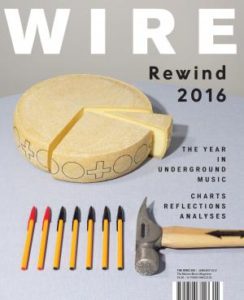Tag Archives: press
Zurkonic Reviews Our Brooklyn Concert March 2017
“I’ve never been moved to jump out of my seat at the end of the performance but I’ll be damned if I didn’t even realize I was standing until I had been clapping rapturously along with the rest of the crowd for a couple minutes.
“The show’s last piece would be the one that solidified Stone as a master of the craft. What unfolded onstage was both sonically accessible and temporally exhaustive as the singer (Akaihirume) and the composer entered into what could be described as an esoteric and aural courting dance that entranced the entire audience.
“I’ve never been one to really romanticize the idea of traveling with a band around the country, but if Carl Stone ever gets the mainstream recognition that elder statesmen like Steve Reich and Philip Glass enjoy, then I might find myself on some strange trip to have my preconceptions about music challenged at every chance.”
Read the full review here.
Latest Release Gets Picked by The Wire as Best Album of the Year 2016 (Archival Category)
“West Coast composer Carl Stone was one of the first to plug in to the possibilities of digital synthesizers, samplers and effects. Electronic Music included “Shibucho”, an audacious sample flip of The Temptations’ My Girl that connects Steve Reich’s Come Out to Chicago footwork, and two explorations of the possibilities of the Buchla synth. Julian Cowley said “While Grandmaster Flash and Afrika Bambaataa were flamboyantly promoting sample based hip-hop, and Joh Oswald was openly flaunting the art of plunderphonics, Carl Stone developed his own idiosyncratic take on sonic bricolage.”
Boomkat Loves Our New Release and Makes Us Laugh Telling Us So
“lights up our pleasure centres like a quid in a fruit machine, using a palette of eastern-tuned scales, processed vocals and pop samples to conjure a majorly playful array of idiosyncratic, angular and intriguing arrangements that resonate with Robert Ashley’s mercurial cut-ups as much as The Automatics Group’s incisive dance pop detournements and the proto-glitch music of Nicolas Collins.
It’s all totally new to us and feels like somebody just opened a big skylight onto our listening lives, flooding us with new sensations between the baroque computer music of Sukhothai (1977) and the wormholing drone of Chao Praya (1973), taking in the soothingly ethereal Shing Kee (1986) and strobing structure of Don II Jang (1982), along with the haunting nocturnal transition of Kuk Il Kwan (1981) to lay out whole new worlds before your ears.”
You can read the full review here
Our Latest Release Score’s Bandcamp’s “Best of Contemporary Classical” November 2016
“This astounding anthology collects two-and-a-half hours of the early electronic experiments of Carl Stone, an L.A. composer who studied under Morton Subotnick and James Tenney and worked with Buchla synthesizers back in the ‘70s before finding his true passion: a kind of experimental sampling approach that presaged the developments of folks like John “Plunderphonics” Oswald and Paul Lansky. There are a couple of those early analog synth pieces—thick, long tone drones—made as a student at Cal Arts, included, but the real thrills come from the sample-based work. Stone’s work relied on tape machines, building layer after layer of the same passage of music—like the minute or so of Renaissance harpsichord music in “Sukothai” that folds in on itself until there are 1024 simultaneous layers of the music piled up, and rhythms disappear in a buzzing haze of abstract sound. Towards the end of 1982, he began working with the now-primitive Publison stereo digital delay unit to create dizzying hall-of-mirrors refractions built from tiny fragments of Asian pop, American R&B and classical records that he manipulated with a maniacal rigor to generate sound profiles that drifted toward fleeting recognizability—such as the lick of “My Girl” in “Shibucho”—before pushing off into different chopped-up patterns. Today’s technology could tackle these time-consuming time experiments with ease, but Stone’s resourcefulness and originality is unmistakable, and these sounds remain fresh decades later.”
Bandcamp is a global community where millions of fans discover new music, and directly connect with and fairly compensate the artists who make it. Their mission is to provide all artists with a sustainable platform to distribute their music, while making it easy for fans to directly support the artists they love. This review is from the Best of Bandcamp Contemporary Classical: November 2016 listings
Textura Reviews Our New 3-LP Release
“The only prosaic thing about Electronic Music from the Seventies and Eighties is its title. Otherwise, the eight pieces (one a digital-only bonus) on this three-LP collection of pioneering work by American electro-acoustic composer Carl Stone constitute an oft-mesmerizing two-and-a-half hours; in fact, of the seven album tracks, five are so extensively explored they each take up a full album side. What makes the release especially significant for students of electronic music’s history and development is that all are previously unpublished pieces, the sole exception being “Shing Kee,” which surfaced on a 1992 New Albion CD release.”
Full review here
Nick Zurko/Zurkonic Really REALLY Likes Our New Release
“Jaw-dropping maximalist achievement, done so through a minimalist methodology…..compositions that, much like the CalArts music library Stone spent many of his hours in, reveal endless surprises and delights upon each listen….incredibly rewarding album.”
Read the full review here
Pitchfork Weighs In With One of the First Reviews of Our 3-LP Set
“Stunning indeed, full of purring drones that at first appear to hardly be moving, only to have them slowly slide and reveal infinite amounts of overtones. It’s evocative of some of my favorite minimal music from this era.
“By-turns lovely, prickly, meditative, and maddening, these eight extended compositions (some two and a half hours of music) showcase drastically different sides of Stone’s work, which previously was relegated to small batch cassette releases in the ’80s and early ’90s. An early adopter of the computer, which he used to create his pieces, Stone’s also worked with turntables and manically manipulated samples. He has electronically elongated source sounds until they take on entirely new topographies. These techniques anticipated later trends of all sorts, from the dense slivers of samples informing the Bomb Squad’s productions to Plunderphonic’s trash-compacting of pop music to Justin Bieber 800% Slower.


